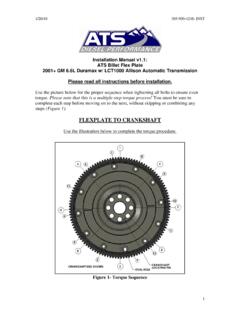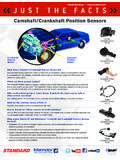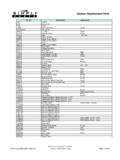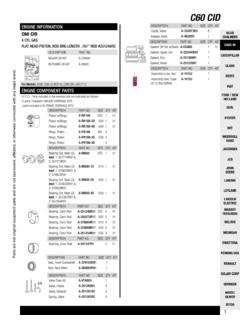Transcription of Crankshaft Offset and it’s Impact on Piston and …
1 1 Crankshaft Offset and it s Impact on Piston and Piston Ring Friction Behavior ABSTRACT Increasing fuel economy in modern passenger car engines has become one of the primary development targets, due to swiftly increasing raw oil prices. Initially, vast progress was achieved in the development of the combustion process. Computer Aided Engineering (CAE) has been one of the keys to success; however, further potential is now being investigated. Currently, the primary focus of engine development engineers is mechanical friction. The greatest potential for reducing friction in the valvetrain lies with the roller contacts and surface treatment.
2 The primary focus of the development direction, for the cranktrain is in reducing bearing diameters. Due to increasing specific loads on the Crankshaft there are clear limits that have been identified. Meanwhile, the potential for the development of the Piston group is almost untouched. Optimization of the Piston skirt contour and/or the ring pack introduces the negative risks blow-by and oil consumption. However, modifications to the Crankshaft Offset are relatively easy design measures that have almost no risk. The potential for friction reduction of the pistons and Piston rings is outlined here through the application of a Crankshaft Offset . Testing and simulation are combined for the following disciplines: Measurements of Piston friction in a fired engine are used to validate the simulation model under some select engine working conditions that have low measurement risks.
3 The influence of Crankshaft Offset is determined for these working points Multibody Simulation (MBS) is used to analyze a wide variety of engine working conditions and different Crankshaft Offset values. The resulting database, characterizes friction behavior and sensitivity regarding Crankshaft Offset . The engine s rpm and load time history, as a result of the vehicle cycle simulation, is used to drive through the previously generated database. The information gathered from that data is used to quantify the energy saved, decrease in the average friction power and the reduction of fuel consumption for a standardized vehicle driving cycle. Utilization of this new approach enables the evaluation of not only the benefits of operating the engine under specific working conditions, but also provides a clear recommendation concerning the magnitude of Crankshaft Offset under consideration for realistic vehicle driving conditions.
4 INTRODUCTION The first step in reducing the mechanical friction in a combustion engine is to identify and quantify the friction sources. Although under fired conditions the friction content will look much different, an initial idea about the share of the different sources of the friction of the entire engine can be identified by measuring the friction of the motored engine, with a step-b-step disassembly of the different components. This Strip Method allows the possibility to evaluate the meaning of the different groups of friction sources. A typical friction share of an inline four cylinder gasoline engine in terms of the Friction Mean Effective Pressure (FMEP) is shown in Figure 1.
5 At 2000 rpm and 100 C, the Piston group and connecting rod bearings together have a relative friction share of more than 40% and the Crankshaft (main bearings) has a share of less than 15%. Assuming, that the four connecting rod bearings may have less than or equal the friction share that the main bearings have, the friction share of the Piston group without connecting rod bearings could be estimated to be more than 25% of the entire engine friction. Therefore, a significant reduction of the Piston group friction will lead to considerable improvements regarding the friction of the entire powertrain. 2 Figure 1: Friction Source Quantification for a Gasoline Engine [7] MEASUREMENT METHOD OF Piston GROUP FRICTION ON FIRED ENGINE For an absolute quantification of the Piston group friction under realistic engine working conditions the strip method is definitely not sufficient, because the behavior for a fired engine is too much different from a motored one.
6 In addition, to fully understand the physical process it is necessary to review also the friction force vs. crank angle rather than only looking at the integrated value of FMEP. Therefore a lot of testing equipment has been developed, to allow accurate measurements of the Piston group friction force [1,2,3,4,7]. Fig. 2 shows the FEV Piston Friction FOrce (PIFFO) measurement setup, working based on a floating liner concept, which allows the measurement of the dynamic Piston friction force using a 3-Component Force Sensor. Due to the dynamics of the system, caused by the inertia of the liner in combination with the flexibility of the force sensors, the technology is limited to engine Speeds up to 3000 rpm.
7 Figure 2: Measurement Setup for Piston group Friction under Fired Conditions [7] DYNAMIC Piston SIMULATIONS The simulation of the Piston dynamics has a long history. While the primary dynamics ( Piston position as function of crank angle) is given by the kinematics of the cranktrain, focus of the Piston simulation is mainly the determination of the Piston secondary motion. Piston secondary motion means the lateral Piston movement and the tilting of the Piston around the Piston pin axis. Since primary and secondary movement of the Piston may be fully described by three degrees of freedom in one plane, Piston dynamics was considered as purely 2d phenomena for years.
8 However, the interaction between Piston and cylinder liner depends on three dimensional physics, so nowadays, with the performance of modern computer hardware, three dimensional Piston dynamics simulation is state of the art [1,5,6]. In general, to support the engine development process under the strict boundary condition of short development times it is, as always, necessary to work with different model refinement levels, depending on the specific questions to be answered in the different development phases. Therefore there are two different ways, to consider the forces between Piston and cylinder liner. 3 HERTZ CONTACT BASED APPROACH Especially, if the exact hydrodynamics between the Piston and the liner is of minor interest, a hertz contact approach may be sufficient to calculate the Piston dynamics.
9 The big advantage is that even the consideration of structural stiffness influences is possible with a limited amount of CPU Time. So, for the calculation of Piston slap noise, a dry contact approach is the perfect solution to come up very quickly with results, showing sufficient accuracy. The big disadvantage of this approach is that the model is not fully physical, but only consists of empirical data that needs to be adjusted. While global stiffness is taken from static FEA and local stiffness is calculated from the Hertz-theory, both, global and local damping effects are completely unknown from the physical point of view and need to be adjusted, when validating such type of simulation model.
10 Global and local stiffness representing the structural stiffness of Piston skirt and cylinder liner on the one hand and the stiffness of the contact as function of the penetration on the other hand need to be modeled as series of two spring-damper systems, as shown in Fig. 3. Figure 3: Global and Local Stiffness and Damping of Dry Contact Model Once the contact pressure is known, it needs to be distributed as forces on the simulation grid of the Piston and the cylinder liner, to calculate resulting force and moment for the Piston secondary motion, as shown in Fig. 4. Figure 4: Force Distribution of Dry Contact Model Beneath NVH applications, also the calculation of the friction between Piston and cylinder liner may be covered by this type of simplified approach.







